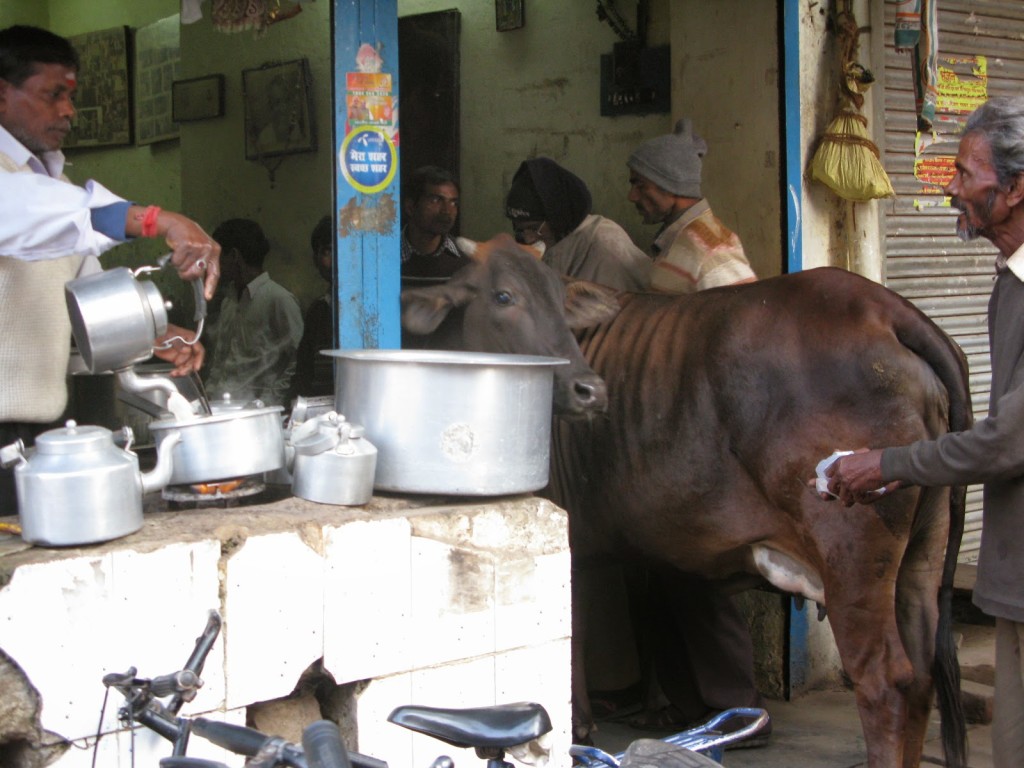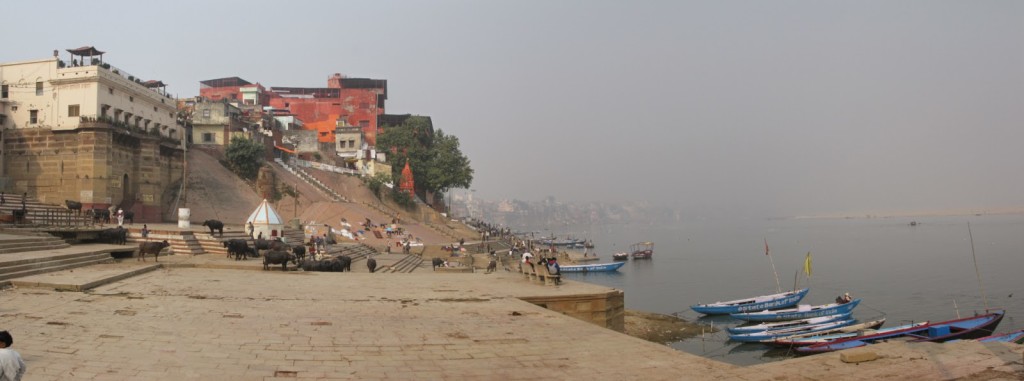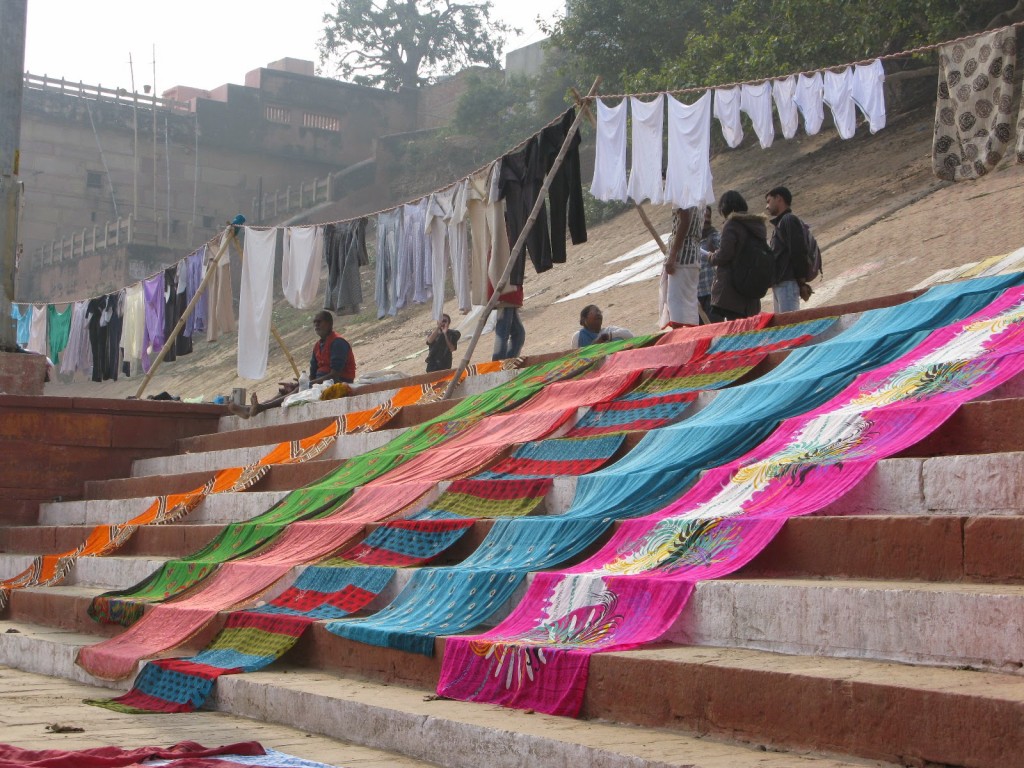The next stop was Varanasi, a new destination for us. The drive in from the airport was long and increasingly depressing – congested, litter-strewn streets typical of any scruffy, nondescript Indian town, and we struggled to locate the guesthouse from the vague address given.
At first sight the Khushi Paying Guesthouse wasn’t inspiring either – a decent size room, but with the bare and slightly shabby appearance typical of budget accommodation in India. But at least there was a good thick blanket on the bed. We would need it – Varanasi was several degrees colder than Delhi.
It was already dark by the time we ventured out to explore the neighbourhood with the main goal of finding somewhere decent to eat. I knew that Assi Ghat was not in the main centre of town, but as one of the most important of Varanasi’s ghats I did expect the area to be a bit better endowed with restaurants. However the streets beteween the main road and the river were dark, a few promising-looking cafes were already closed, and we couldn’t find the pizza place that Google maps had indicated. For a while it looked as though we might have to take a chance on one of the small number of hotels that advertised the presence of an unseen restaurant.
Then by chance we stumbled across the Angeethee, a new looking place at the far side of an unlit square. On seeing us, the manager called out to promise ‘fine dining’ – that was stretching a point, but it was actually a very decent place to which we returned every evening but one. It was vegetarian, as are all restaurants close to Varanasi’s ghats, but beer was surreptitiously offered at a price we felt too high.
The streets looked little better in the daylight – with no pavement the main road demanded total concentration in avoiding speeding motorbikes while dodging round the usual clutter of dogs, rubbish piles, vegetable stalls and cows. And the cows here were significant obstacles – huge things more like the cows found in the British countryside than the normal Indian kind. We learned later that some bright spark had decided to import European cows because they produce more milk, without taking into account that for a large cow to produce a lot of milk it needs a lot of good food, and the usual street cow diet of cardboard and kitchen scraps just doesn’t cut it. The European cows were abandoned to interbreed with the native cows, and their large but skinny descendants prowl the streets hunting for something to eat.
And so to Varanasi’s main event – the Ganges. At this time of year it is still wide, wider than the Thames in London, but slow moving. The colour of milky tea, it doesn’t look at all inviting, but that doesn’t deter the Hindu pilgrims who come to wash away the bad karma from all this life’s misdeeds and, for some, to die within sight of the holy river, thus ensuring their escape from the cycle of death and rebirth.
Varanasi therefore has a larger than usual quota of sadhus, gurus and yogis, many with dusty western hangers-on who sit silently by, presumably hoping to acquire spritual enlightenment by some kind of osmosis.
The ghats stretch for miles all along Varanasi’s curving waterfront. Each has its own purpose and character, from the bustling main bathing and puja Dashashwamedh ghat, ghats for cremations (pay by the kilo for your firewood), laundry ghats where the washing is spread on the ground to dry (no extra charge for buffalo hoofprints), ghats for landing pleasure or fishing boats, ghats for watering livestock, and ghats for playing cricket in even more challenging conditions than usual, with boys running up and down the steps to field balls bouncing off buildings on one side or headed for the river on the other.
Walking along the ghats involves the negotiation of countless steps and changes of level, and incessant offers of boat rides. For some reason it is assumed that visitors will undoubtedly wish to be rowed across to the other side of the river to be deposited on the flat, barren, kilometre wide sandbank that forms the inside of the meander, ‘relax’ for an hour(!), then be rowed back. As one of our dearest friends would say, “What is point?!”.
But still, walking along the banks of the wide river in the misty, milky sunlight, the ancient, golden buildings on one side facing the almost colourless, featureless east bank, boats full of Indian tourists feeding swooping flocks of seagulls, bright splashes of colour from saris and marigold garlands, men stripped to underpants and lunghis immersing themselves in the murky shallows oblivious to the astronomical faecal coliform count – suddenly the scruffiness doesn’t matter and you feel the magic. Even the occasional cow or buffalo carcass drifting slowly down the river doesn’t spoil the mood.
On our last evening we went to Assi Ghat for the evening prayer ceremony. Only one priest here rather than the five at Dashashwamedh, but that, and the smaller crowds with only a dozen or so tourists, gave a more intimate feel. The priest turned and dipped and swayed on his dais with a selection of flaming lamps and incense burners before leading the congregation down to the edge of the river to launch their little candle and flower offerings onto the dark water.
We followed, having been persuaded into buying a couple of offerings from a particularly engaging girl of about 9 who spoke remarkably good English (I hope our money goes on her schooling) and silently sent them floating off with thoughts of our family and friends around the world, and those no longer in it.






